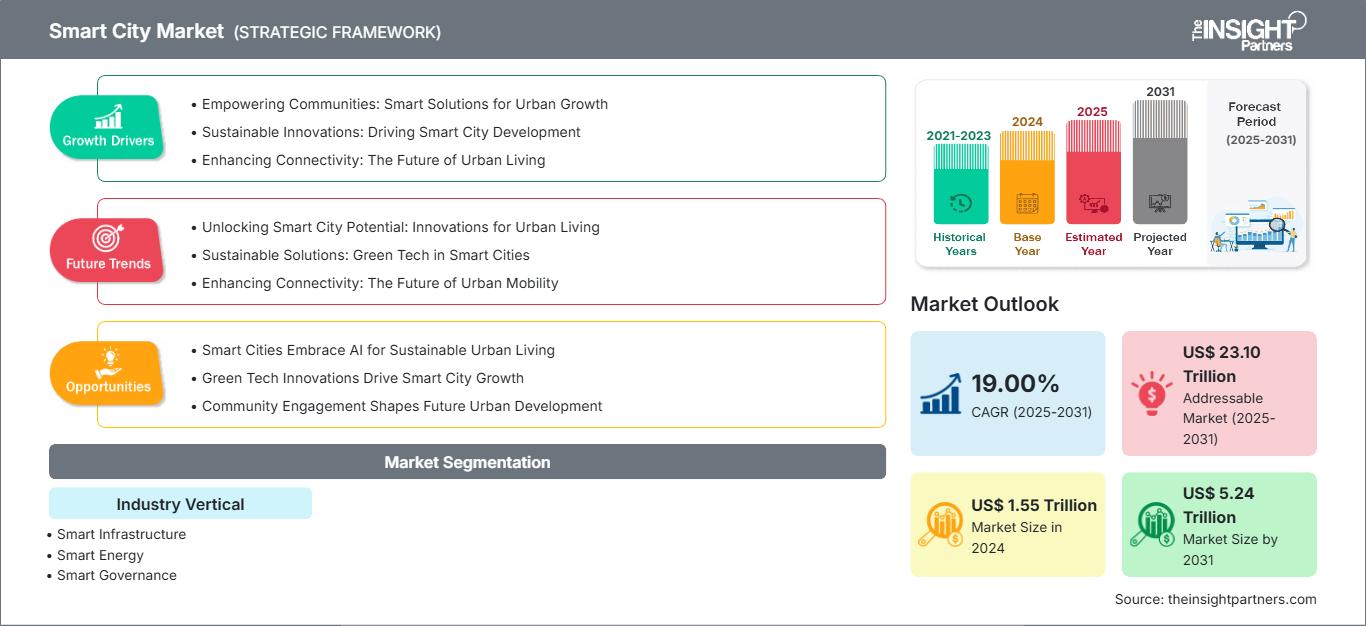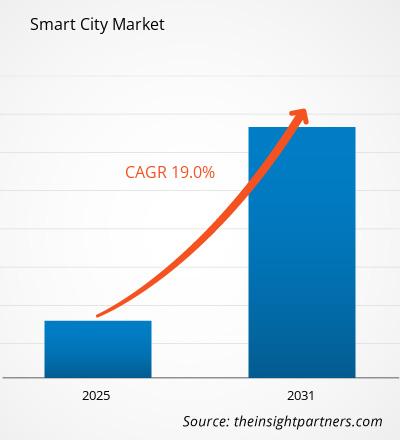预计智慧城市市场规模将从2022年的10942.3亿美元增长到2031年的31105.8亿美元;预计2022年至2031年的复合年增长率将达到19.0%。
智慧城市的概念是指城市或省份的各个方面都基于先进技术。这些城市利用数字技术和互联网,通过优化能源使用和提高市民安全来提升服务水平和生活质量。智慧城市的概念旨在开发强大的互联互通和基础设施,以实现实时信息访问,从而构建一个高效连接市民、服务提供商和管理人员的管理系统。此外,政府通过为城市提供基本基础设施,确保居民积极参与提高服务的整体可持续性和生产力。
智能基础设施技术随着时间的推移发生了显著变化,各种学科,例如用于设施和应急响应管理的楼宇自动化、建筑能源优化、停车管理和室内通信系统,如今正被广泛采用。此外,绿色建筑计划已成为许多国家关注的焦点,尤其是在欧洲、北美和亚太地区。对降低能源消耗的关注以及对环境废物泛滥的担忧是智慧城市发展的主要驱动因素。预计交通运输将成为智慧城市市场预测期内的另一个重点关注领域。
自定义此报告以满足您的要求
您将免费获得任何报告的定制,包括本报告的部分内容,或国家级分析、Excel 数据包,以及为初创企业和大学提供超值优惠和折扣
智慧城市市场: 战略洞察

- 获取本报告的主要市场趋势。这个免费样本将包括数据分析,从市场趋势到估计和预测。
您将免费获得任何报告的定制,包括本报告的部分内容,或国家级分析、Excel 数据包,以及为初创企业和大学提供超值优惠和折扣
智慧城市市场: 战略洞察

- 获取本报告的主要市场趋势。这个免费样本将包括数据分析,从市场趋势到估计和预测。
能源枯竭和低效的资源管理正逐渐成为全球关注的焦点。这推动了全球对智能能源解决方案的需求。智能能源管理系统利用传感器、先进的电表、可再生能源、数字控制和分析工具来自动化、监控和优化能源分配和使用。此类系统通过平衡不同利益相关者(消费者、生产者和供应商)的需求来优化电网的运行和使用。智能能源基础设施领域涌现出多项创新,例如分布式可再生能源发电、微电网、智能电网技术、储能、自动需求响应、虚拟发电厂,以及电动汽车和智能家电等需求侧创新。这些创新为整个城市提供了一个扩展的智能能源设备网络,可以详细查看能源消耗模式,从而实现以社区为基础的能源监控计划并提高建筑物的能源效率。
智慧城市市场区域分析
从区域角度来看,北美在 2021 年占据了全球智慧城市市场的最大份额。该地区所有工业部门广泛采用技术先进的解决方案,促进了北美智慧城市市场的增长。政府通过宣布补贴、税收抵免和为行业技术开发提供资金等方式加大对技术采用的支持,这进一步催化了市场,从而为在该地区运营的智慧城市市场参与者提供了丰厚的商机。例如,2021 年 11 月,美国联邦政府宣布根据《基础设施投资与就业法案》拨款 5 亿美元,以克服智慧城市的挑战。此外,该地区众多智慧城市市场参与者不断创新和开发产品,进一步推动了北美智慧城市市场的发展。
市场洞察 - 智慧城市市场行业垂直洞察
根据行业垂直细分,智慧城市市场规模可细分为智慧基础设施、智慧能源、智慧治理、智慧交通、智慧医疗和智慧教育。预计智慧交通领域在预测期内的复合年增长率最高。智慧交通是基于新技术构建的创新型交通和移动基础设施,旨在节省资源,实现效率最大化。云计算、4G、机器对机器学习等关键技术的部署以及在新型项目中的运营预计将更广泛地应用于铁路等智能交通系统,在全球范围内提供高效的客运和货运服务,从而为智慧城市生态系统中的众多行业参与者创造大量机遇。这也将吸引各类资本家和投资者,从而推动智慧交通市场的巨大增长。
智慧城市市场区域洞察
The Insight Partners 的分析师已详尽阐述了预测期内影响智慧城市市场的区域趋势和因素。本节还探讨了北美、欧洲、亚太地区、中东和非洲以及南美和中美洲的智慧城市市场细分和地域分布。
智慧城市市场报告范围
| 报告属性 | 细节 |
|---|---|
| 市场规模 2024 | US$ 1.55 Trillion |
| 市场规模 2031 | US$ 5.24 Trillion |
| 全球复合年增长率 (2025 - 2031) | 19.00% |
| 历史数据 | 2021-2023 |
| 预测期 | 2025-2031 |
| 涵盖的领域 |
By 垂直行业
|
| 覆盖地区和国家 | 北美
|
| 市场领导者和主要公司简介 |
|
智慧城市市场参与者密度:了解其对商业动态的影响
智慧城市市场正在快速增长,这得益于终端用户需求的不断增长,而这些需求的驱动因素包括消费者偏好的演变、技术进步以及对产品优势的认知度的提升。随着需求的增长,企业正在扩展其产品线,不断创新以满足消费者需求,并抓住新兴趋势,从而进一步推动市场增长。

- 获取 智慧城市市场 主要参与者概述
- 2021 年 10 月,西门子股份公司宣布收购 Squills。此次收购增强了该公司的移动解决方案,例如预订和票务软件。
- 2021 年 5 月,微软公司与 Itron 公司建立战略合作伙伴关系,共同为客户提供高度先进的移动设备管理 (MDM) 服务。
智慧城市市场规模分为五大区域——北美、欧洲、亚太地区 (APAC)、中东和非洲以及南美。2022 年,北美以可观的收入份额领先市场,其次是欧洲。此外,预计亚太地区将在 2022 年至 2031 年期间在智慧城市市场中实现最高的复合年增长率。
全球智慧城市市场的主要参与者包括 ABB 有限公司;思科系统公司;甲骨文公司;微软公司;以及 IBM 公司。除此之外,研究还分析了其他几家公司,包括埃森哲、通用电气公司、施耐德电气、西门子股份公司和爱立信股份公司。
- 历史分析(2 年)、基准年、预测(7 年)及复合年增长率
- PEST和SWOT分析
- 市场规模、价值/数量 - 全球、区域、国家
- 行业和竞争格局
- Excel 数据集
近期报告
客户评价
购买理由
- 明智的决策
- 了解市场动态
- 竞争分析
- 客户洞察
- 市场预测
- 风险规避
- 战略规划
- 投资论证
- 识别新兴市场
- 优化营销策略
- 提升运营效率
- 顺应监管趋势




















 获取免费样品 - 智慧城市市场
获取免费样品 - 智慧城市市场